The abilities to map and characterize relic light and better understand the origins of the universe are enabled with exceptional instruments — and collaborations.
BENJAMIN L. SCHMITT, HARVARD-SMITHSONIAN CENTER FOR ASTROPHYSICS, AND JOSEPH SERIO, VERTEX OPTICS INC.
The field of experimental cosmology is unique among the physical sciences. It uses the entire observable universe as a laboratory, within which examinations of large-scale physical phenomena can help physicists answer some of the most fundamental questions in science. The concept that our universe originated in a hot Big Bang was first developed in the mid-1940s by George Washington University professor George Gamow. Gamow’s theory was borne out by the discovery of the cosmic microwave background (CMB) by Robert Wilson and Arno Penzias in the early 1960s.
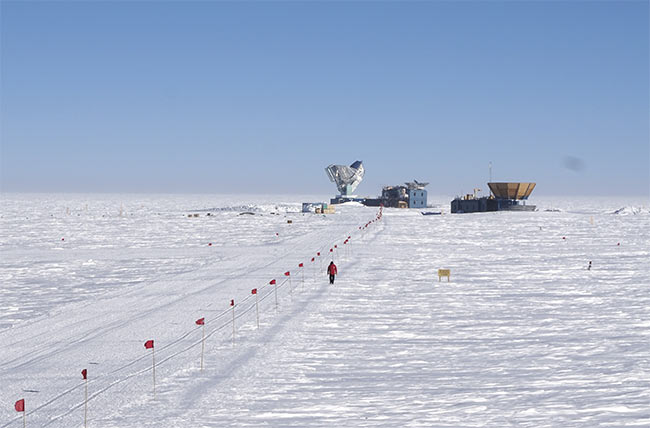
The Amundsen-Scott South Pole Station, November 2019. Courtesy of John Kovac.
The CMB is the oldest relic light in the
universe, radiation resulting from the Big
Bang. Theories suggest that the CMB originated after a period known as inflation, in which the universe rapidly expanded and cooled from a hot, opaque primordial plasma, with the CMB being the last light scattered during expansion into a transparent universe. Since the discovery of the CMB, experimental cosmologists the world over have developed advanced technologies to measure this light with increasing precision, fundamentally enhancing our ability to directly characterize the physical properties and evolutionary history of the observable universe.
The search for B-mode polarization
Over the past few decades, high-precision temperature and polarization maps of the CMB have been made. Yet, despite the rich scientific results they have generated, many mysteries remain locked in this radiation. One of the greatest scientific challenges of our time is to make empirical measurements of the CMB that will confirm how the universe evolved in its nascent form, from the moments immediately following the Big Bang until the opaque universe expanded and cooled enough to result in the CMB. If a specific, faint polarization signal can be measured in the CMB radiation — known as B-mode polarization — then experimental cosmologists will be able to confirm that the inflationary theory of the early universe in fact holds true. Given the opacity of the early universe in this period, confirmation of this polarization signal in the CMB would allow scientists to effectively observe the universe all the way back to its very origin. In other words, the scientific stakes could not be larger.
When fully deployed and operational in mid-2021, the project will consist of four telescopes targeting B-mode polarization of the CMB at large angular scales.
Over the past three months, professor John Kovac and his team at the Harvard-Smithsonian Center for Astrophysics, along with collaborators from Caltech, Stanford, and the University of Minnesota, have been able to deploy the first of four groundbreaking telescopes. These telescopes are aimed at constraining the CMB polarization signals required to confirm or constrain inflation with unprecedented sensitivity.
The project is known as the BICEP Array experiment and it is located at one of the most inhospitable and remote research sites on the planet, the Amundsen-Scott South Pole Station in Antarctica. When fully deployed and operational in mid-2021, the project will consist of four telescopes targeting B-mode polarization of the CMB at large angular scales, with each telescope able to take measurements in a specific frequency range.
The first BICEP Array telescope receiver, recently deployed and now operating at the South Pole, has simultaneous sensitivity at 30 and 40 GHz. The second, third, and fourth receivers will operate at 95, 150, and 220/270 GHz, respectively, and will be deployed in 2021 to enable the BICEP Array experiment to become fully operational. The wide range of frequencies covered by the experiment are required to ensure that CMB polarization signals targeted by the 95- and 150-GHz receivers are not confused with signals from our own Milky Way. These signals include galactic synchrotron radiation (detected by the 30/40-GHz receiver) and galactic dust emission (detected at 220/270 GHz).
At full deployment, the BICEP Array experiment will operate more than 30,000 custom-designed detectors called transition-edge sensor bolometers. The detectors will be able to precisely probe the CMB in both temperature and polarization. To ensure sensitivity to CMB photons, which will reach the BICEP Array experiment at ~2.73 K, the detectors must be cryogenically cooled using a He4/He3/He3 sorption fridge, cooling the focal plane to 250 mK.
The detectors themselves reside behind a set of cryogenically cooled, precision-fabricated optics in each telescope receiver. The design of the first field-deployed BICEP Array receiver, BA1 (Figure 1), operates with 30/40-GHz sensitivity and showcases the technological developments critical to this undertaking.
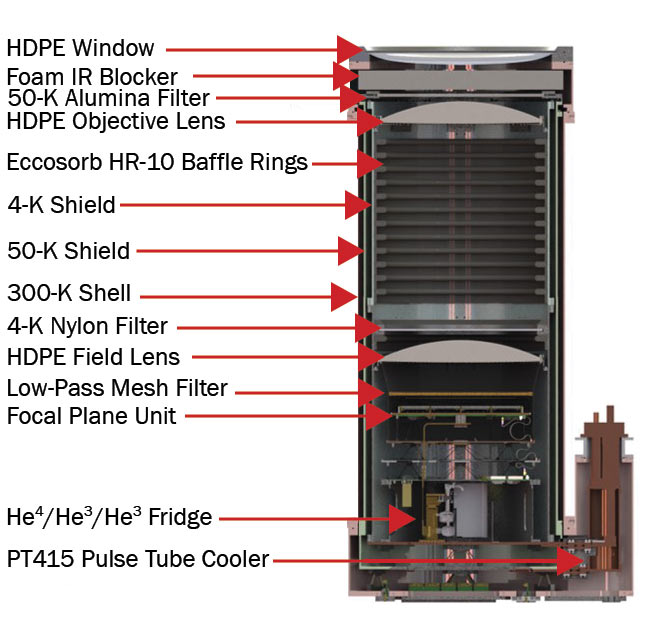
Figure 1. Cross-sectional overview of critical hardware components of the 30/40-GHz-sensitive receiver. Precision optical elements, including field and objective lenses, were fabricated by Vertex Optics of Rochester, N.Y. Courtesy of BICEP/Keck Collaboration.
To achieve sensitivity requirements, the design of the BA1 receiver relies upon 637-mm-diameter high-density polyethylene (HDPE) bi-aspheric lenses. The BA1 optics, which are cryogenically cooled to 4 K during observing operations, require precise alignment and bolt-hole patterns for assembly, such that the optics can be held in proper dimensional tolerance while the lenses and mounting hardware undergo thermal contraction within the receiver assembly. This alignment requires placement accuracy to a few tens of microns when the receiver is cold and undergoing normal observing operations. Working from 100-lb blanks, the sheer size and weight of the lenses challenge the limits of optical experts and their available tool sets.
Partnering up
Initially, the Harvard-Smithsonian scientists encountered barriers when seeking a partner with the capacity, know-how, and willingness to manufacture the lenses, adding pressure to the group’s deployment schedule. To develop critical scientific instrumentation, infrastructure, and logistical supply chains in Antarctica, projects aiming for polar deployment operate under strict timeline constraints similar to NASA launch windows. Because of severe and inhospitable weather in the South Pole, researchers can’t just book a commercial flight whenever an experiment is ready. Personnel deployments under the U.S. Antarctic Program can only land at the South Pole during the austral summer between late October and mid-February. If an experiment is not ready to ship out by October, the entire research team must then wait another year to try again.
The first BICEP Array telescope receiver, recently deployed and now operating at the South Pole, has simultaneous sensitivity at 30 and 40 GHz.
In early 2019, with precision lens fabrication still on the critical development path for the BICEP Array, Kovac and his team went in search of an optical manufacturing firm that would be able to produce the first set of BA1 lenses in just a few months. Kovac contacted Jayson Tierson and Joseph Serio of Vertex Optics Inc. and flew to Rochester, N.Y., to meet with them. Immediately following that meeting, Tierson and Serio took a tape measure to their ultrasonic grinder and determined the grinder could make the BA1 lenses after modifications were made, including an upgrade to its rotary work spindle (C-Axis) and software.
Soon thereafter, Vertex received the
first pair of giant HDPE blanks to manufacture the prototype. These cumbersome blanks measured 680 mm (27 in.) sq × 110 mm (4.5 in.) thick and weighed ~100 lbs each.
Prior to shipment to Vertex, the blanks underwent an initial heat annealing process at Harvard that distorted them, significantly changing the dimensions of the large blanks while they relieved stress. These were by far the largest parts either Tierson or Serio had ever worked on in their combined 50 years of experience in the field.
The prototype material, HDPE, presented its own challenges due to its coefficient of thermal expansion, requiring the team to anticipate and account for material changes in shaping and annealing (expanding in thickness while shrinking in diameter). The team also needed to consider the material’s propensity for scratching and embrittlement over the course of the project. Initially, Vertex had acquired a small model coordinate measuring machine (CMM). But the project, which presented a worthy challenge, provided the impetus for an investment in the metrology needed to sufficiently test these prototype lenses in-house (Figure 2).
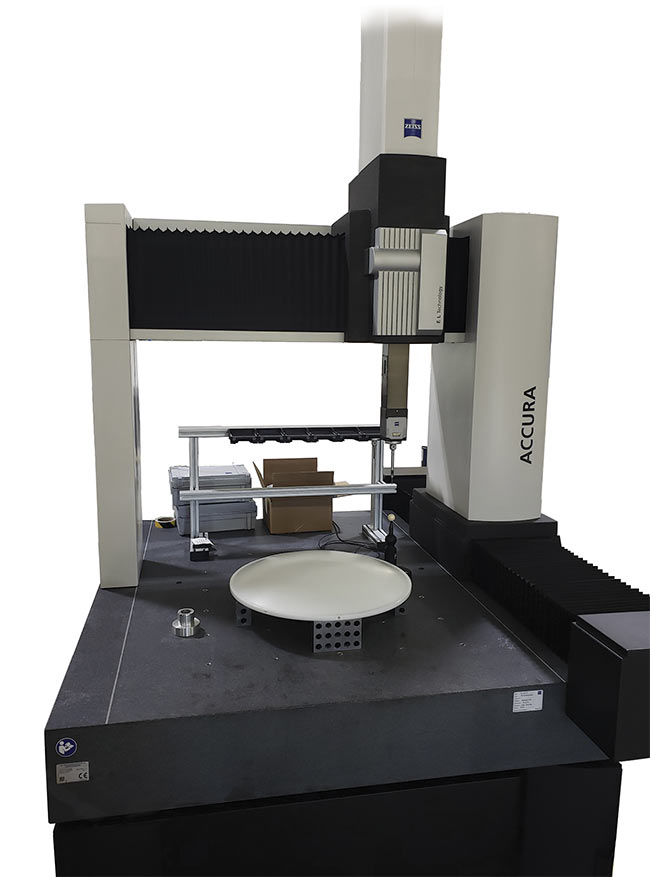
Figure 2. The 637-mm, bi-aspheric lens measured with the Zeiss ACCURA bridge-type CMM. Courtesy of Vertex Optics.
This new CMM, capable of measuring
over 1 m, ensured that the HDPE lenses were held within the proper dimensional tolerance at each step of the manufacturing process. Figures 3 and 4 show the HDPE lenses for the BA1 receiver, along with the optomechanical subsystem
components and assemblies required
to precisely mount the optics during operation.
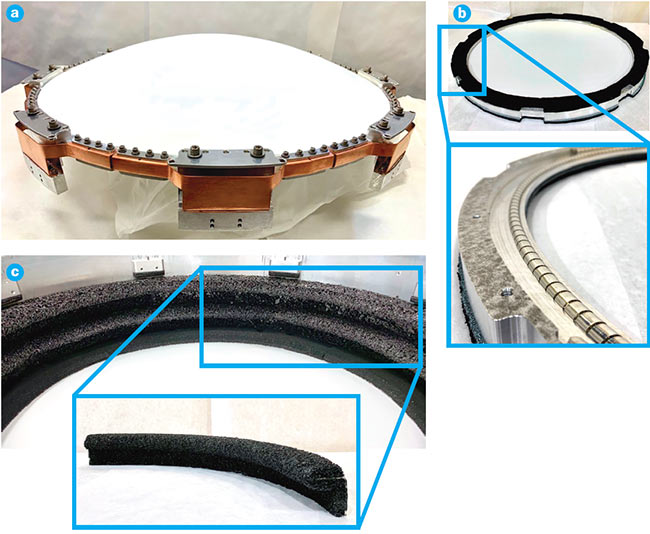
Figure 3. The critical precision optics and custom-designed optomechanical components central to the 30/40-GHz receiver, BA1. Objective lens assembly (a); 4-K nylon filter assembly (b); field lens assembly (c). Courtesy of Harvard-Smithsonian Center for Astrophysics.
In addition to modifications to the ultrasonic grinder and onboard metrology, development of custom fixturing and tooling were also required for fabrication. Vertex’s in-house machine shop helped to reduce manufacturing time and ensure that the optical components needed for early integration and testing by the Harvard BICEP Array team were delivered on time and on budget. With the first BICEP Array receiver complete and ready to ship, the research team headed to Antarctica, with the initial wave of the team touching down at the South Pole in early November 2019. The last of the team will depart Antarctica in mid-February following the successful deployment of the first stage of the BICEP Array experiment, with the exception of a single winter-over engineer, who will operate the telescope through the isolated nine-month observing season.
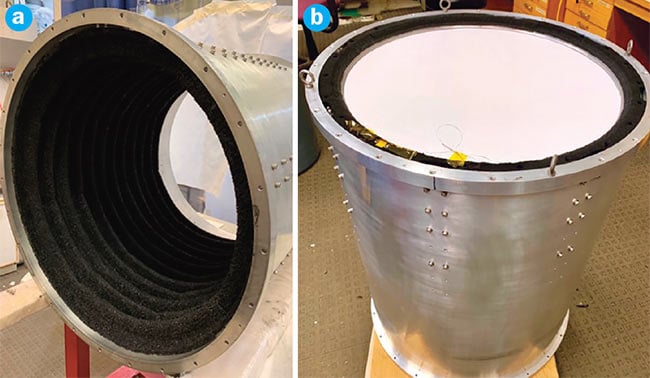
Figure 4. Critical integrated subsystems central to the 30/40-GHz receiver, BA1. Upper 4-K optics tube assembly (a); lower 4-K optics tube assembly (b). Courtesy of Harvard-Smithsonian Center for Astrophysics.
Next steps
With the first BICEP Array HDPE optics now fully integrated and operating in the BA1 receiver at the South Pole, Vertex and Harvard are currently working on the production of the next set of lenses that will operate within other receivers in the experiment. These lenses will be made of alumina and will require a more technically challenging meniscus optical geometric profile.
The development of successful alumina optical manufacturing procedures will not only be crucial to the ultimate success of the BICEP Array experiment, but will also serve as a critical technology development pathfinder for an even larger U.S.-led experimental cosmology initiative called CMB Stage 4, organized with support from the National Science Foundation and the U.S. Department of Energy.
CMB-S4, as it is known, will enable the U.S. to lead a worldwide effort to continue to probe the CMB in temperature and polarization over the next decade and beyond by developing about 20 more telescopes of varying scales to be deployed both in the Atacama Desert in northern Chile and at the South Pole. Undoubtedly, CMB-S4, like the BICEP Array’s operations underway now, will uncover more clues about the origin and early evolution of our universe.
If new discoveries are made, it will be due to collaborations such as these, which showcase what can happen when the creative, innovative spirit of American manufacturing firms and scientists come together.
Acknowledgment
The BICEP Array experiment operates as
part of the South Pole Observatory at the Amundsen-Scott South Pole Station, which
is supported by the U.S. National Science Foundation’s Office of Polar Programs.
Meet the authors
Benjamin L. Schmitt is a Postdoctoral Research Fellow and project development scientist at the Harvard-Smithsonian Center for Astrophysics (CfA). He received both master’s and doctoral degrees in physics and astronomy from the University of Pennsylvania, where he developed the CMB imagers currently deployed in Chile. Schmitt has previously served as European energy security advisor at the U.S. Department of State, and has completed both Fulbright and NASA Space Technology Research Fellowships.
Joseph Serio is co-founder and vice president of Vertex Optics Inc. He has worked in nearly every facet of optical manufacturing and engineering, project management, and workforce development.